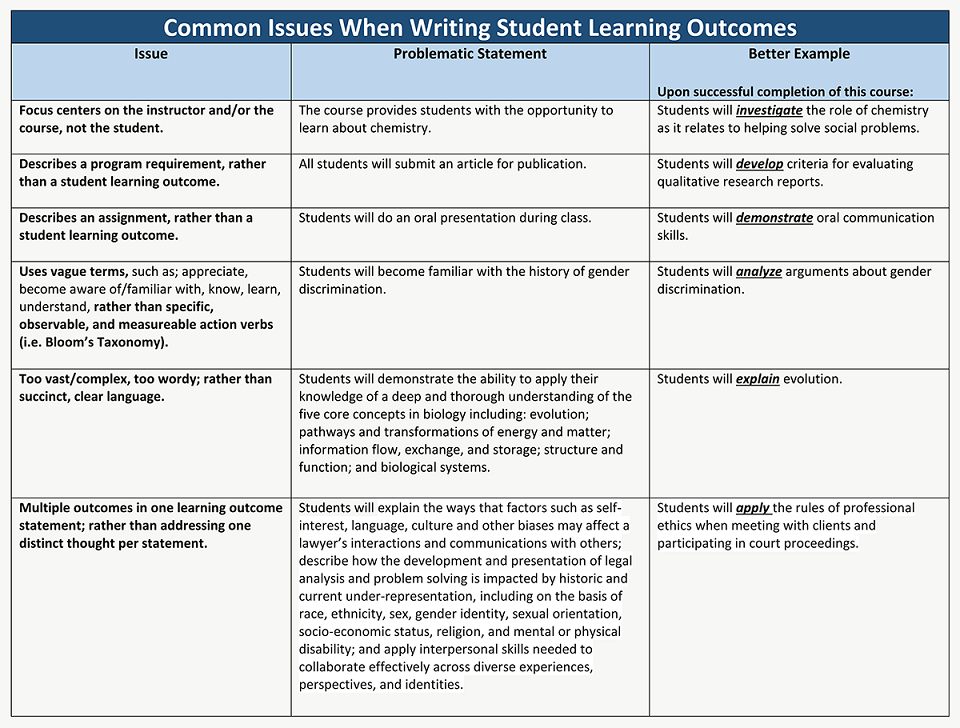Assessment Resources
- Writing effective student learning outcomes
- Curriculum Mapping
- Co-Curricular Assessment
- CAS Standards
Resources for UAC Liaisons
How to Write an Effective Student Learning Outcome Statement
A student learning outcome statement should meet the following criteria:
-
- Focuses on the learner and is written from the student’s point of view;
- Describes the knowledge, skills, attitudes, and habits of mind that students develop from a learning experience (Suskie, 2009);
- Begins with an action verb (below) and the verb is appropriate to the level of learning expected for the course;
- Maps to the curriculum by aligning with the program-level student learning outcomes;
- Can be quantitatively or qualitatively assessed (i.e., is specific, measurable, and observable);
- Offers a timeline for completion of the desired learning;
- Is realistic, not aspirational-all passing students should be able to demonstrate the knowledge or skill described by the outcome by the conclusion of the course;
- Is collaboratively authored and collectively accepted by all faculty teaching the same course.
Action Verbs
AFFECTIVE learning is demonstrated by behaviors indicating attitudes of awareness, interest, attention, concern, and responsibility; ability to listen and respond in interactions with others; and the ability to demonstrate those attitudinal characteristics or values which are appropriate to the test situation and the field of study.
COGNITIVE learning is demonstrated by knowledge recall and the intellectual skills: comprehending information, organizing ideas, analyzing and synthesizing data, applying knowledge, choosing among alternatives in problem-solving, and evaluating ideas or actions.
PSYCHOMOTOR learning is demonstrated by physical skills: coordination, manipulation, grace, strength, speed; actions which demonstrate the fine motor skills such as use of precision instruments or tools; or actions which evidence gross motor skills such as the use of the body in dance or athletic performance.
Examples:
Upon successful completion of this course, students will be able to…
-
- Recall accurately the attachments, actions and innervation of the muscles of the upper extremities, lower extremities, head and trunk. (Discipline-Kinesiology; Bloom’ Taxonomy-Remembering)
- Explain the contribution of economics to the analysis of non-market social issues. (Discipline-Economics; Bloom’s Taxonomy-Understanding)
- Conduct a regression analysis. (Discipline-Statistics; Bloom’s Taxonomy-Applying)
- Determine the magnitude and direction of magnetic fields created by moving electric charges. (Discipline-Physics; Bloom’s Taxonomy-Analyzing)
- Compare images and structures using traditional art historical practice. (Discipline-Art History; Bloom’s Taxonomy-Evaluating)
- Develop a personal teaching philosophy statement. (Discipline-Education; Bloom’s Taxonomy-Creating)
Self-Check: How do I know if a Student Learning Outcome (SLO) is well-written?
-
- Is the SLO written from the student’s point of view?
- Does the SLO describe what students should be able to do as a result of their learning?
- Does the SLO align with the intended goals of the program?
- Does the SLO begin with an action verb?
- Is the SLO:
-
- Specific?
- Measurable?
- Observable?
- A result of learning?
- Does the SLO include an endpoint for completion?
- Do you have, or can you create activities which enable students to learn the desired SLO?
- Do colleagues teaching the same course agree that the SLO focuses on an essential element of the course?
- Can students’ demonstration of the student learning outcome be used to make decisions on how to improve the program?
References:
Anderson, L.W. (Ed.), Krathwohl, D.R. (Ed.), Airasian, P.W., Cruikshank, K.A., Mayer, R.E., Pintrich, P.R., Raths, J., & Wittrock, M.C. (2001). A taxonomy for learning, teaching, and assessing: A revision of Bloom’s Taxonomy of Educational Objectives (Complete edition). New York: Longman.
Higher Learning Commission. Emerging Leaders in Assessment Workshop. September, 2019, Detroit, Michigan.
Maki, P.L. (2010). Assessing for learning: Building a sustainable commitment across the institution (2nd ed.) . Sterling, VA: Stylus.
Suskie, L. (2009). Assessing student learning: A common sense guide. (2nd ed.). San Francisco: Jossey-Bass.
CAS Standards
The University Assessment Committee requires co-curricular service units to align their operational and program outcomes with either the CAS Professional Standards for Higher Education, or another appropriate professional organization’s standards to frame and anchor their assessment work with national best practices. The Office of Assessment, Accreditation, and Program Review maintains copies of both the CAS standards and self-assessment guides. Please contact Alana Malik, alana.malik@utoledo.edu, to request a copy of your unit’s CAS materials.



